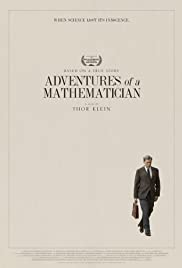
ADVENTURES OF A MATHEMATICIAN
Poland, 2020, 102 minutes, Colour.
Philippe Tlokinski, Esther Garrel, Sam Keely, Joel Basman, Fabian Kocjecki, Ryan Gage, Sabine Tambrea.
Directed by Thorsten Klein.
What kind of adventures do mathematicians have? Adventures of the mind? Adventures of the brain? Adventures in applying their equations and theories? In this case, the mathematician had adventures at Los Alamo’s and the creation of the atomic bomb as well as realisations of its aftermath.
The mathematician at the centre of the film is a Polish academic who left Lvov in the 1930s, lectured in mathematics at Harvard, was caught by the war in Europe in 1941, wanting his family to leave Poland and come to the United States where he and his brother lived in Boston. In some ways he was a genial character, in other ways rather prickly. He lectured the students, and gave them examples of calculus applications and other theories with reference to gambling and probabilities.
He was in from given information about recruiting by Robert Oppenheimer for the team at Loss Alamo’s and applied, was accepted, married a young woman who had encountered in something of a whirlwind courtship, moved to New Mexico.
The mathematician’s name was Stan and this film is based on a memoir that he wrote. While he is an interesting character in many ways, the portrayal is somewhat sketchy, moving rapidly over time, highlighting his bonds with his family, but showing his abrasive behaviour with some of his colleagues. The screenplay does show some maths classes, blackboards with formally, some discussions at Los Alamo’s, a quick explanation of wrote relativity to his fiancee, but it does not give a great deal of background to the mathematics or even to the teambuilding the bomb, their experiments, discussions leading up to the final July 1945 test, in the aftermath of the end of the war in Europe.
The characters do range some moral issues. There is the colleague who goes to the Soviet Union and gives scientists there all the information from loss Alamo’s. There is Oppenheimer himself and the moral challenge to creating the bomb and to witnessing the bombing of Hiroshima and Nagasaki. Attention, rather emotionally for the audience, is given to one scientist who begins to blame himself for his contribution of the bomb and his statements of horror that women and children were burnt alive.
The action continues after the war, will having something of a breakdown, collapsing, having to retire, irritated by the attentions of his wife, although some remarks of hers stimulate his mathematical intuition. However, a colleague, Johnny (who is later instrumental in computer development) looks at his conclusions, takes him back to loss Alamo’s better explorations for the development of the hydrogen bomb.
Before the final credits we learn that he did return to lecturing at Harvard.
A portrait, a return to the history of atomic development, the raising of moral issues – but not quite the adventurousness suggested by the title.
1. The title? Emphasis on adventure? Emphasis on mathematics? Intellect, brain, applications of theories and equations?
2. The memoir, Stan Lum, sketching his early life in Poland, the move to Harvard, his lectures, recruited for loss Alamo’s, his work there, his marriage, the birth of his daughter, abrasive with colleagues, the dropping of the bomb, his breakdown, revival, subsequent career?
3. The Harvard settings, university, classrooms, apartments? Los Alamos, the desert, the plant, the interiors? The musical score?
4. The opening, the trek through the mountains, moving to 1941, the reprisal of the tracks seen at the end, the two friends standing contemplating the desert, contemplating their past?
5. The portrait of Stan Lum, his age, mathematics, moving from Poland, leaving the family behind, wanting them to come to America, the phone calls and the personal feelings, at present in the United States, their bond? His lecturing, the authorities and the issue of his using gambling analogies? The recruiting, his decision to go to New Mexico? The social, the encounter with François is, talking, the explanation of relativity, the bond, marriage, her moving with him, pregnancy, the birth of their daughter?
6. The abrasive aspects of his personality, with colleagues, the clashes with Edward Teller, the responsibilities, the engineers, the mathematicians? Discussions of theories, limitations? His attempts at apologies? Continued criticisms? Eventual contributions and insights?
7. Pricewise, her background, meeting Stan, discussions, proposal, marriage, moving to New Mexico, the birth of their daughter, his collapse, her trying to help, his reaction against her? And his decision to return to New Mexico?
8. Issues of the atomic bomb, Oppenheimer and his team, trying to beat the Nazis, the bomb as a deterrent? The end of the war in Europe, and the deaths of Stan’s family? The testing of the bomb in July 1945, the dropping of the bombs? The reaction of the physicists of the mathematicians? As deterrent, saving lives, but the criticism of burning women and children alive? The consequences?
9. The personalities of the variety of scientists and mathematicians, discussions, clashes, contributions?
10. Stan, collapse, breakdown, alone, his wife trying to help, the daughter playing in the sand? Françoise and her comment, giving Stan inside, preparing formally, Johnnie examining them, his return to New Mexico?
11. A portrait rather than adventures?